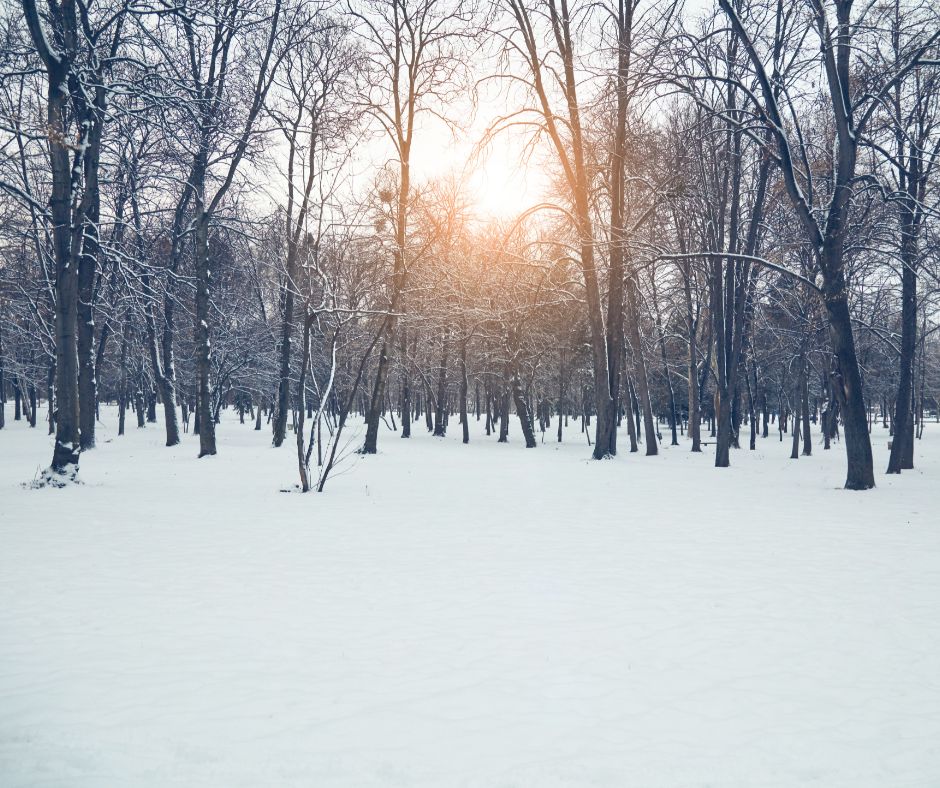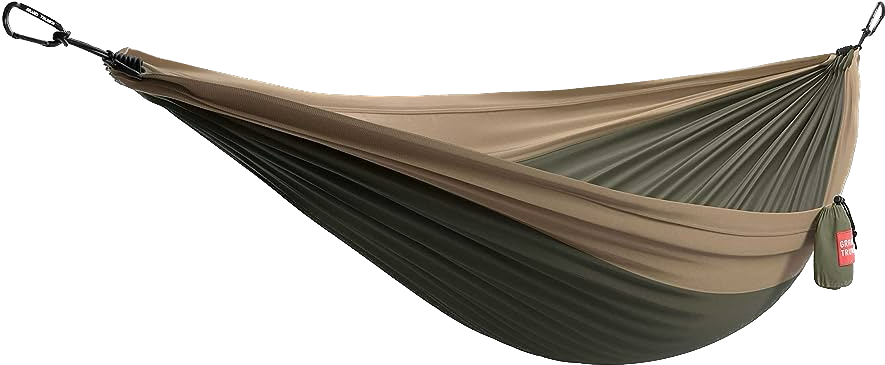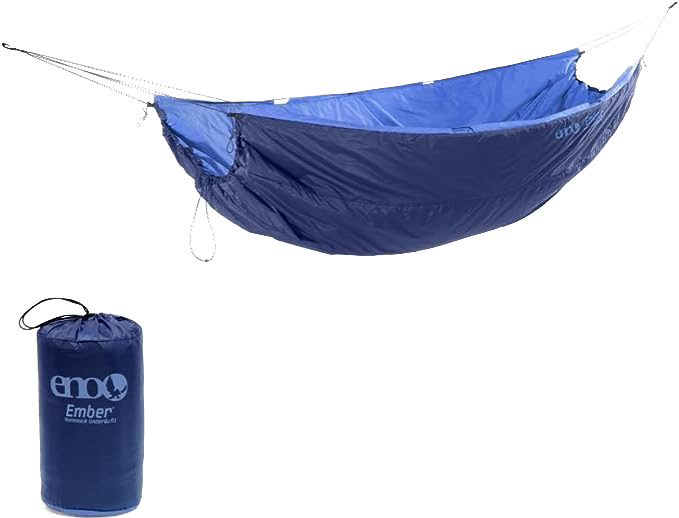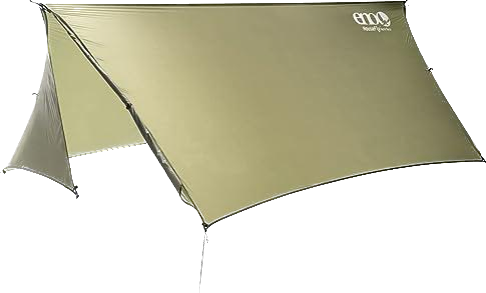Imagine lying in a cozy hammock, gazing at the stars, as a gentle breeze rustles the leaves above you. The only thing that could make this serene scene any more perfect is knowing that despite the dropping temperatures, you’ll stay toasty warm all night long. winter hammock camping can be a truly magical experience, but learning how to stay warm in a hammock is paramount for enjoying your time outdoors. This comprehensive guide will provide you with step-by-step instructions to ensure you stay warm and comfortable in your hammock during cold-weather camping.
Key Takeaways
- Choose the ideal camping hammock spot with consideration of natural windbreaks, sun exposure, and potential hazards.
- Invest in an insulated sleeping pad, mummy-style sleeping bag, underquilt, and top quilt combination for optimal warmth.
- Utilize hot water bottle trick and layering techniques to stay dry and warm when cold weather hammock camping.
1. Choose the Right Winter Hammock

When it comes to hammock camping in cold weather, the choice of hammock can make a significant difference in your comfort and warmth. Here are some factors to consider when choosing a winter hammock:
- Material: Look for a hammock fabric made from durable, high-quality materials that can withstand harsh winter conditions. Nylon or polyester are excellent choices. Nylon is highly durable, weather-resistant, and quick to dry, making it ideal for snowy or rainy conditions. Polyester, while slightly heavier, is extremely resilient and has superior resistance to UV rays and weather, ensuring your hammock maintains its strength and vibrant color even after exposure to harsh winter elements.
- Insulation: Some hammocks come with built-in insulation, which can provide an extra layer of warmth. These hammocks typically have a double-layer design, with an insulating material sandwiched between the layers to create a barrier against the cold. The insulating layer can be made of various materials, including synthetic fibers or down, each offering different levels of warmth, weight, and packability. If your hammock doesn’t come with built-in insulation, you’ll need to add an underquilt for insulation.
Remember, staying warm in a hammock during winter is all about insulation and protection from the elements. Therefore, investing in a high-quality winter hammock and the right accessories can make your cold-weather hammock camping experience a warm and enjoyable one.
Note: While camping hammocks are designed to withstand rain and harsh weather, you should never leave your hammock outside for long extended periods of time. This is especially true when hammocking in winter weather.
2. Choosing the Ideal Hammock Spot to Stay Warm
The key to a warm and comfortable hammock camping experience in cold weather is not just about having the right gear, but also about knowing where to set up your hammock. Here are some factors to consider:
- Natural Windbreaks: Choose a location that has natural wind protection. Setting up your hammock in an area shielded by trees, rocks, or hills can significantly reduce the cold wind’s impact on your camping spot.
- Sun Exposure: If you’re hammocking in the cold, sunlight can be your friend. Position your hammock in a spot that receives plenty of sunlight during the day. The sun’s rays can provide an extra layer of warmth to your hammock. In fact, studies have shown that direct sunlight can increase your perceived temperature by up to 10-15 degrees Fahrenheit.
- Potential Hazards: Avoid setting up your hammock near dead trees or branches that could potentially fall and cause injury. Also, consider the potential for local wildlife encounters and be prepared for changing weather conditions.
A well-chosen location provides natural wind protection, reducing the impact of cold wind on your camping spot. Additionally, look for a hammock camping spot that allows you to adjust easily to the changing weather conditions.
3. Use an Insulated Sleeping Pad

When it comes to cold weather hammock camping, an insulated inflatable sleeping pad is a must. The sleeping pad works as a barrier between your body and the cold air below, preventing heat loss due to conduction. It’s like adding an extra layer of insulation beneath you, significantly improving your overall comfort and warmth.
What temperature should you use a hammock sleeping pad?
When the temperature drops below 70 degrees Fahrenheit, it’s a good idea to start using a sleeping pad. Even if the weather doesn’t feel that cold, remember that the temperature can drop significantly during the night, and it’s better to be prepared.
The difference in temperature when using a sleeping pad versus not using one can be quite significant. For instance, without a sleeping pad, you might feel cold even at temperatures as high as 65-70 degrees Fahrenheit. With a good quality insulated sleeping pad, you can comfortably sleep in temperatures as low as 40 degrees Fahrenheit. Of course, this can vary depending on other factors such as your sleeping bag, clothing, and individual tolerance to cold.
4. Mummy-Style Sleeping Bag

For extra warmth, try a mummy-style sleeping bag inside your hammock.
The mummy-style sleeping bag differs from traditional sleeping bags in its ability to provide superior insulation and heat retention. The close-fit design reduces the amount of air your body needs to warm up, thus keeping you warmer than in a traditional, rectangular sleeping bag. The hood feature also helps to prevent heat loss from your head, a critical aspect when temperatures drop.
What temperature should you use a mummy-style sleeping bag?
When it comes to deciding when to use a mummy-style sleeping bag, consider the temperatures you expect to encounter. As a general rule of thumb, use a mummy-style sleeping bag for temperatures below 50 degrees Fahrenheit. This can change depending on the R-Value of your particular bag.
To stay extra warm, try combining a mummy-style sleeping bag with an insulated pad or underquilt. When you lay in your sleeping bag, your body weight compresses some of the insulation in the bag. Having an additional insulating layer below you will help mitigate any heat loss caused by this compression. Not to mention, if you get hot during the night, you can always remove or take out a piece of gear to get comfortable.
This leads us to our next tip…
5. Underquilt and Top Quilt: Your Hammock’s Best Friends
When it comes to hammock camping in the colder months, an underquilt and top quilt combination is a game-changer. This duo is a great alternative or enhancement to traditional sleeping bags and is specifically designed for hammock insulation.
The Underquilt

The underquilt hangs beneath your hammock, providing an insulating layer that shields you from wind chills and traps heat. Acting like a lightweight blanket, it forms a cozy cocoon that helps to maintain your body temperature, even in the coldest conditions.
The Top Quilt

The top quilt is exactly what the name suggests – a quilt that wraps around your upper body, acting like a coat or sweater, and helps to retain your body’s natural heat.
Some people use top quilts or even a fleece blanket in place of sleeping bags. They’re able to keep the camper warm like a sleeping bag. However, unlike traditional sleeping bags, top quilts are designed for easy entry and exit, making them a more convenient choice for hammock campers.
6. Clothing Layers
When it comes to layering clothing for hammock camping, there are three critical layers to think about.
The first is the base layer, which is closest to your skin and is primarily responsible for managing moisture by wicking sweat away from your skin, ensuring you stay dry and comfortable.
The second layer, the mid-layer, serves as your main insulating layer, trapping heat close to your body to help keep you warm.
Finally, the outer layer is your protective shield against the elements, designed to be windproof and waterproof to protect you from rain, snow, and wind.
Here’s what you should wear for each layer:
- Base Layer: Opt for materials such as synthetic fabrics or merino wool. These materials excel at wicking moisture away from your skin, keeping you dry and comfortable.
- Mid Layer: Fleece or wool make excellent choices for this insulating layer. They provide significant insulation, are breathable, and still provide some insulation even when wet.
- Outer Layer: Your outer layer should be windproof and waterproof to protect you from the elements. Look for materials that are also breathable to allow sweat vapor to escape.
Don’t forget about your head, hands, and feet. A significant amount of heat can be lost through your head, so wearing a hat or balaclava can help keep you warm.
Remember, it’s easier to cool down if you’re too warm than to warm up when you’re cold. So when in doubt, layer up!
7. Tarp Setup for Wind and Weather Protection

Setting up a tarp is a crucial step in ensuring your hammock camping experience is warm and weatherproof. The right tarp can protect you from wind, rain, snow, and even the chilling effect of dew.
Tarp Placement
The placement of your tarp can significantly impact its effectiveness. Ideally, you want to hang your tarp above your hammock, creating a roof that shields you from the elements. The corners of the tarp should be anchored securely to the ground, creating a windbreak that helps retain heat and block cold winds.
The height and angle of your tarp may need to be adjusted based on the weather conditions, with a lower and more angled setup providing the best protection in windy or stormy conditions.
Tarp Material
When it comes to selecting a tarp opt for a tarp made from durable and weather-resistant materials like nylon or polyester. Nylon tarps are highly durable, weather-resistant, and quick to dry, making them ideal for snowy or rainy conditions. On the other hand, polyester tarps, although slightly heavier, are extremely resilient and offer superior resistance to UV rays and weather.
For a balance of durability, weather resistance, and weight, I recommend a nylon tarp for your hammock camping needs.
For added warmth, consider a tarp with a reflective coating on the underside. The reflective surface can direct heat back towards your hammock, providing an additional source of warmth and making your cold-weather hammock camping experience a bit more comfortable.
8. Hot Water Bottle Trick

When the cold is creeping in, a simple hot water bottle can be your best friend. This trick is an old-time favorite among campers and can provide a surprising amount of warmth on a chilly night.
To use this technique, fill a sturdy, leak-proof bottle with hot water before you get into your hammock. Make sure the bottle is sealed tightly, then place it in your sleeping bag. Position it near your feet or core area, as these are the parts of your body that can get cold the fastest. The heat from the water bottle will radiate throughout your sleeping bag, keeping you warm and cozy throughout the night.
Remember to be careful when filling and sealing your hot water bottle. The water should be hot but not boiling to avoid burning yourself or damaging the bottle. Always check the seal before placing the bottle in your sleeping bag to avoid any leaks during the night.
9. Stay Dry

Staying dry is a critical aspect of hammock camping, especially in colder weather. Moisture can significantly reduce your gear’s insulating properties and lead to a cold and uncomfortable night. Here are some tips to help you stay dry:
- Use a Tarp: A tarp is your first line of defense against rain and snow. Set it up above your hammock to create a protective shelter.
- Waterproof Your Gear: Ensure your sleeping bag, underquilt, and clothing are made of water-resistant materials or are properly treated with a waterproofing spray.
- Avoid Condensation: Use a breathable hammock to avoid condensation buildup, and don’t breathe inside your sleeping bag.
- Pack a Dry Set of Clothes: Always have a dry set of clothes packed in a waterproof bag to change into if necessary.
What to Do If You Get Wet in the Wilderness
In the event that you find yourself wet in the wilderness, the two most crucial steps to take are:
- Change Into Dry Clothes: If you have an extra set of clothes, change into them immediately. Wet clothes can rapidly decrease your body temperature, making you susceptible to hypothermia.
- Boost and Maintain Your Core Temperature: Once you’ve changed into dry clothes, the next step is to keep your body’s core temperature up. If you’re cold, try doing some physical activity to generate body heat. This active approach will help raise your core temperature quickly.
Ultimately, if you get wet the goal is to get warm and stave off hypothermia.
Summary
Hammock camping in cold weather can indeed be a fun and unique experience when armed with the right preparation and gear. Starting with choosing the right hammock and campsite to invest in gear like underquilts and mummy bags, you can significantly enhance your warmth and comfort. In essence, successful winter hammock camping hinges on effective insulation and protection from the elements.
Frequently Asked Questions
So how cold is too cold for a hammock? The Cold Butt Syndrome

As a general rule, temperatures below 50 degrees Fahrenheit are considered too cold for hammock camping without the proper insulation.
At these temperatures, the lack of insulation beneath you, which you would typically have in a traditional tent setup, can cause you to lose body heat rapidly. This is often referred to as “Cold Butt Syndrome” among hammock campers.
To combat this, use an underquilt, which hangs beneath your hammock to provide a layer of insulation. A sleeping pad can also help and works even better if paired with a top quilt or a suitable sleeping bag.
As mentioned earlier, don’t leave your hammock outside in winter conditions for long extended periods of time. You’ll extend the life of your hammock greatly by only bringing your hammock outside when you’re using it.
How do you keep a hammock warm indoors?
Keeping a hammock warm indoors largely follows the same principles as outdoor hammock camping. The key is insulation. Use an underquilt or a sleeping pad to create a layer of insulation beneath you. This will help trap your body heat and prevent it from escaping through the bottom of the hammock.
If it’s particularly cold, consider using a top quilt or a blanket for additional warmth. You could also layer up with warm clothing. Remember, the goal is to prevent heat loss, so any method that accomplishes this will help keep your hammock warm indoors.



 Hello there, we're Vira Outdoors!
Hello there, we're Vira Outdoors!

